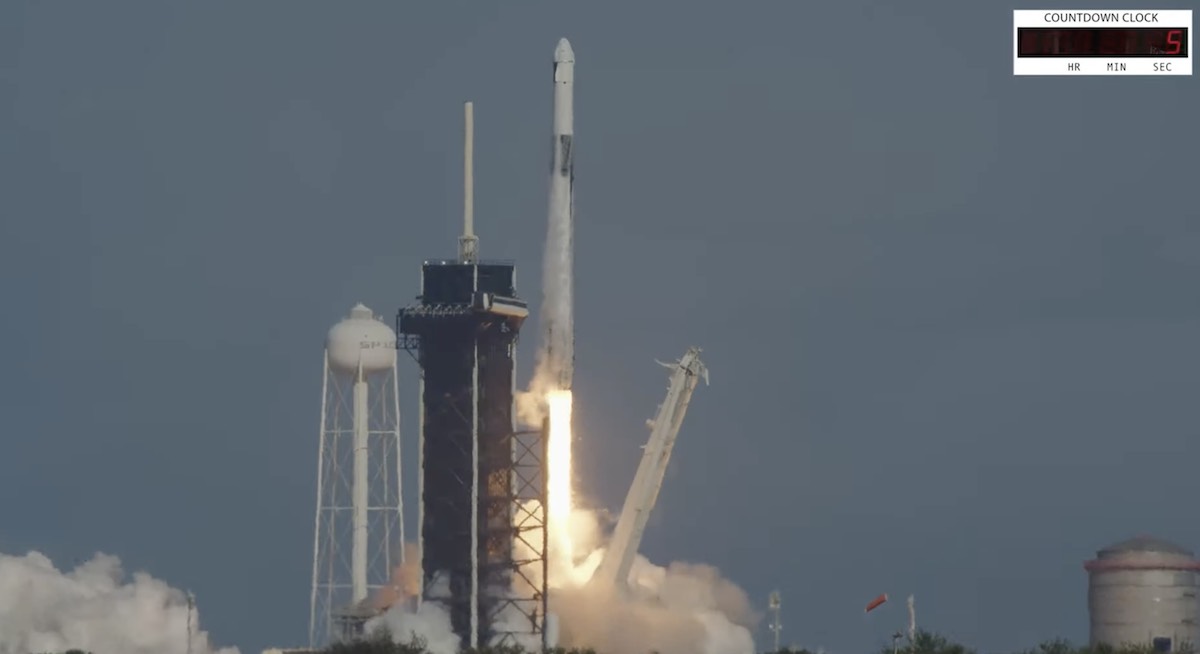Live coverage of the countdown and launch of a SpaceX Falcon 9 rocket from Launch Complex 39A at NASA’s Kennedy Space Center in Florida. The Falcon 9 rocket launched SpaceX’s 26th resupply mission to the International Space Station. Follow us on Twitter.
SFN Live
After a launch attempt earlier in the week was scrubbed due to bad weather, SpaceX sent a Dragon cargo capsule toward the International Space Station Saturday with nearly four tons of supplies and experiments. Liftoff on a Falcon 9 rocket from Kennedy Space Center occurred at 2:20 p.m. EST (1920 GMT).
SpaceX called off the first launch attempt for the resupply mission Tuesday due to rainfall and cloud cover at the Florida spaceport. The Falcon 9 rocket remained on the launch pad at Kennedy to await the next launch opportunity Saturday.
SpaceX was unable to launch the cargo mission around the Thanksgiving holiday, a period of busy travel in the United States, because the Federal Aviation Administration wanted to ensure airspace is clear for commercial airline traffic.
With the successful launch Saturday, the Cargo Dragon spacecraft will dock with the Harmony module on the International Space Station at 7:30 a.m. EST (1230 GMT) Sunday. Astronauts on the space station will open hatches and begin unpacking cargo inside the pressurized compartment of the Dragon spacecraft.
The Falcon 9 rocket headed downrange northeast from Kennedy, powered by nine Merlin engines generating 1.7 million pounds of thrust. The rocket shut down its first stage booster about two-and-a-half minutes into the mission, allowing the booster to descend to landing on a drone ship about 186 miles (300 kilometers) downrange in the Atlantic Ocean about seven-and-a-half minutes after liftoff.
The booster, tail number B1076, completed its first flight to space on the CRS-26 mission. The Dragon capsule, also brand new, deployed from the Falcon 9’s upper stage about 12 minutes after liftoff to begin the journey to the International Space Station.
Stationed inside a firing room at a launch control center at Kennedy, SpaceX’s launch team began loading super-chilled, densified kerosene and liquid oxygen propellants into the 215-foot-tall (65-meter) Falcon 9 vehicle at T-minus 35 minutes.
Helium pressurant also flowed into the rocket in the last half-hour of the countdown. In the final seven minutes before liftoff, the Falcon 9’s Merlin main engines were thermally conditioned for flight through a procedure known as “chilldown.” The Falcon 9’s guidance and range safety systems were also configured for launch.

After docking of the new cargo capsule, astronauts at the space station will open hatches and unpack supplies, experiments and other equipment stowed inside the Dragon spacecraft’s pressurized compartment. At the end of the mission, the reusable capsule will undock from the station and head for a parachute-assisted splashdown off the coast of Florida in mid-January with several tons of cargo.
The payloads on-board the Dragon capsule include two new ISS Roll-Out Solar Arrays, or iROSA units, to upgrade the space station’s power system. Astronauts on the station will venture outside the complex next month to help install and deploy the new roll-out arrays, which will augment power produced by the station’s original solar arrays. The existing solar array wings launched on space shuttle missions between 2000 and 2009.
The solar arrays are rolled up on spools like yoga mats during launch. The space station’s robotic arm will remove the spools from their mounting posts inside the Dragon spacecraft’s rear cargo bay and move them to attachment points on the lab’s left-side and right-side solar power truss.
The roll-out solar panels will open up to partially cover the existing arrays. This pair of iROSA units follows the launch of the first two in 2021. The final two roll-out solar arrays are scheduled to launch on a SpaceX resupply mission next year.
Other cargo on the CRS-26 mission includes experiments to test the growth of dwarf tomatoes on the space station, a portable hand-held microscope that will help astronauts collect medical imagery of their own blood samples, and a technology demonstration to gather data on the construction of flexible structures in space.
Read more details in our mission preview story.
ROCKET: Falcon 9 (B1076.1)
PAYLOAD: Cargo Dragon (CRS-26)
LAUNCH SITE: LC-39A, Kennedy Space Center, Florida
LAUNCH DATE: Nov. 26, 2022
LAUNCH TIME: 2:20:43 p.m. EST (1920:43 GMT)
WEATHER FORECAST: 70% chance of acceptable weather; Low risk of upper level winds; Low risk of unfavorable conditions for booster recovery
BOOSTER RECOVERY: “Just Read the Instructions” drone ship east of Jacksonville, Florida
LAUNCH AZIMUTH: Northeast
TARGET ORBIT: 118 miles by 130 miles (190 kilometers by 210 kilometers), 51.6 degrees inclination
LAUNCH TIMELINE:
- T+00:00: Liftoff
- T+01:12: Maximum aerodynamic pressure (Max-Q)
- T+02:27: First stage main engine cutoff (MECO)
- T+02:30: Stage separation
- T+02:38: Second stage engine ignition
- T+02:42: First stage boost back burn ignition (three engines)
- T+03:15: First stage boost back burn cutoff
- T+05:45: First stage entry burn ignition (three engines)
- T+05:59: First stage entry burn cutoff
- T+07:06: First stage landing burn ignition (one engine)
- T+07:33: First stage landing
- T+08:37: Second stage engine cutoff (SECO 1)
- T+11:49: Cargo Dragon separation
MISSION STATS:
- 187th launch of a Falcon 9 rocket since 2010
- 196th launch of Falcon rocket family since 2006
- 1st launch of Falcon 9 booster B1076
- 1st flight of Dragon capsule C211
- 160th Falcon 9 launch from Florida’s Space Coast
- 57th SpaceX launch from pad 39A
- 151st launch overall from pad 39A
- 6th launch of an upgraded Cargo Dragon vehicle
- 26th SpaceX cargo mission to the International Space Station
- 53rd Falcon 9 launch of 2022
- 54th launch by SpaceX in 2022
- 52nd orbital launch attempt based out of Cape Canaveral in 2022
Email the author.
Follow Stephen Clark on Twitter: @StephenClark1.
